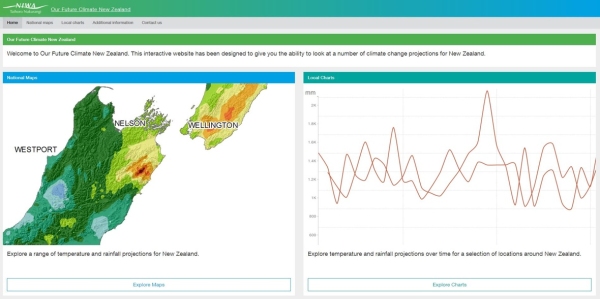On this page:
- Early climate modelling
- Today's global models
- Representative Concentration Pathways
- The changes we can expect
Climate change projections are made using computer models. Huge amounts of climate data collected around the world feed into these models.
By understanding how our climate has changed in the past and using future greenhouse gas trajectories, models can estimate how our climate will change in the future. New Zealand has already warmed by about 1 degree over the past century.
Early climate modelling
Early climate models created in the 1970s were very simple. They were first used to predict how greenhouse gases would warm the earth’s climate. But as computing technology and science progressed, models have become more advanced, allowing scientists to make more detailed projections.
Today’s global models
Global models use a grid to divide the earth into small square areas, each with different climatic features – models then make predictions for each of these squares. Global climate models use about a 150km square size – this is also the resolution of the New Zealand Earth System Model.
These squares are too big to make detailed predictions for different parts of New Zealand, so NIWA’s climate modellers use the High Performance Computing Facility, or supercomputer, to ‘downscale’ global models to a finer grid size of 12km. This process means we can make more detailed predictions for specific parts of the country - like estimating rainfall in Dunedin in the 2080s.
Representative Concentration Pathways
When scientists make projections, four different scenarios are usually modelled. These scenarios are based on ‘Representative Concentration Pathways,’ or RCPs from the Intergovernmental Panel on Climate Change (IPCC).
RCPs refer to differing concentrations of greenhouse gases in the atmosphere and represent four potential futures based on how much greenhouse gas humans continue to emit. The four scenarios are:
- RCP8.5: very high greenhouse gas concentrations – emissions continue to rise throughout the 21st century
- RCP6.0: mid-high concentrations - emissions peak around 2080, then decline
- RCP4.5: low-mid concentrations - emissions peak around 2040, then decline
- RCP2.6: low concentrations - emissions peak around 2020 and decline substantially thereafter
The changes we can expect
Even with efforts to reduce emissions worldwide, we are still certain to see some continued climate change and associated impacts into the future. However for a low-emissions scenario, climate change will be much more moderate than if we continue to emit a lot of greenhouse gases.
Temperature
Like much of the Earth, New Zealand will be warmer everywhere. Hot days – days above 25 degrees Celsius – are likely to be far more frequent.
Because of warmer temperatures, much of New Zealand may be frost free by 2100.
Rainfall
The areas of New Zealand that already receive high amounts of rainfall – such as the West Coast of the South Island – may receive even more rainfall in the future.
In New Zealand, our prevailing wind direction is a westerly. Westerly winds collect moisture from the Tasman Sea and the Southern Ocean and carry it toward New Zealand. These moist airflows are forced upwards when they reach the Southern Alps on the West Coast of the South Island. As the air rises and cools, moisture is released as rain and snow. Because of this process – called ‘orographic precipitation’– the West Coast records high amounts of rainfall.
New Zealand’s prevailing westerly winds are projected to increase with climate change. Stronger and more frequent westerly winds are likely to increase orographic rainfall on the West Coast of the South Island. Some areas are projected to receive up to 40% more rainfall.
Rainfall is likely to decrease in the dry areas of New Zealand that already receive low amounts of rainfall – the far east and north of the North Island, e.g. Northland, Hawkes Bay, Gisborne and the Wairarapa.
Typically, much of New Zealand is likely to experience drier springs and summers and wetter winters.
Drought
Meteorological drought can occur during extended periods of low rainfall. High temperatures can also exacerbate drought conditions as more evaporation occurs during hot weather. New Zealand will be much more prone to drought as our climate warms.
For much of the country, the number of days with rainfall is likely to decrease which will lead to longer dry spells. Warmer temperatures leading to moisture being evaporated from soils will further increase the risk of drought.
Extreme events
Changes to our rainfall and temperature will increase the likelihood of extreme events.
This is because a warmer atmosphere can hold more energy and moisture, leading to heavier and more intense rain.
For the same reason, ex-tropical cyclones (cyclones that originate in the Pacific) may be stronger and more intense when they reach New Zealand.
Bush fires may also increase in frequency and intensity as drought-like conditions become more common.
Our Future Climate NZ
Visit Our Future Climate NZ to explore what New Zealand's climate might look like in the future.

